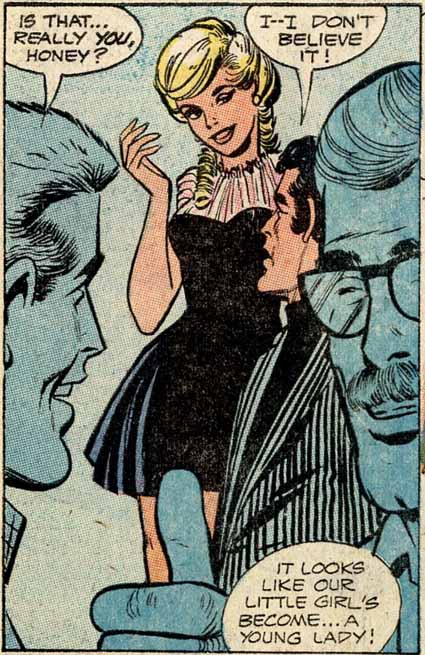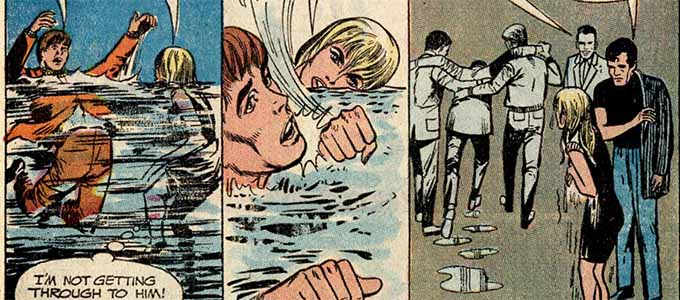This page may contain one or more affiliate links, which means that if you purchase a product through that link, I may receive compensation. The links will be identified with the text "affiliate link". Click to learn more.
Ah yes, Girls’ Romance comic books of yesteryear – the epitome of literary greatness. A treasure trove of love and melodrama woven together with such finesse that even Shakespeare himself must have blushed. The dazzling artwork and riveting storylines, immortalizing the lives of star-crossed lovers, emerge unparalleled in their depth and complexity. Truly, these stories have bestowed upon us a pinnacle of art and culture akin to toothaches and soggy cardboard.
You might wonder why these are worth reading. Well, I would say quite a lot. These stories are always interesting because they reflect the time period so well. They also make me wonder what it would be like being a girl, especially when the title of the story is “I wish I wasn’t born a girl.”
What happens in Girls’ Romances 148 is that a teenage tomboy decides she wants to be pretty so she can catch a man (which apparently, is what’s most important in life) so she wears a dress and stuff and tries to bag her prize. When she comes down the steps wearing the dress for the first time, some guy in the foreground is giving a thumbs up, as if to say, “yeah, I’d tap that”. The panel is so funny I almost burst out laughing. I also thought the same thing when she dives into a lake to save some guy from drowning, and punches him in the face so he wouldn’t squirm. If you can buy this (Affiliate Link) story, it is worth every penny just so you can pass it around and show your friends. I don’t know where writers come up with this stuff.
With such unparalleled levels of literary genius, who could resist delving into the illustrious world of Romance comics? Indeed, what better way could one spend their time than scouring thrift shops or attics in pursuit of such timeless masterpieces? Each page offers a captivating exploration of passion, a smattering of humor, and delicate dollops of tragedy, providing an experience on par with slowly peeling off stubborn, ancient wallpaper. Yet despite comparisons to tedious tasks and subtle mockery, the bold and adventurous of heart will undoubtedly find solace in reading these relics of days long gone, forever entertaining themselves with melodramatic absurdity.

History of Romance Comics
Typically, comics remind us of the superheroes’ exploits, full of bravery and risk. But many years ago, comic history embraced an era where romance ruled the world of comic books. The era, which spanned from the 1940s through to the mid-1970s, saw a high demand for romance comics that were solely aimed at women.
In the period of time, women started to leave their homes and become independent. This shift in society also ushered in a different kind of comics. The conclusion of World War II created a demand for entertainment that could help society adapt to the changing norms and values. So, romance comics came into vogue, showing readers a view of girls’ lives and relationships.
Young Romance is one of the pioneers in this genre; it was created by Joe Simon and Jack Kirby in 1947. Love, heartbreak, and drama were the focus of this comic book series, which won over a large number of female readers within a short span. It was the first women-centered comic book that other romance comics emulated later.
These comic books told tales about young women and their relationships with men. They used to present an idealized representation of love, in which good-looking men would chase the heroines like a predator following prey, wooing them over for romance. The women were usually innocent and did not have any experience in life, hence waiting for some sort of knight in shining armor to come along and take care of all their issues at once. While the stories were predictable, they provided readers with an opportunity to forget about their daily routine.
An example of the well-liked romance comic is Young Love, which was first published by Joe Simon and Jack Kirby in 1949. It tells tales of deep love, hidden relationships, and unauthorized love affairs. The publication’s success launched other romantic titles like Girls’ Romances, Secret Hearts, and Heart Throbs.
The comics did not just aim at entertainment alone; they also engaged in social issues of that period. These social topics include feminism, marriage, and family relationships, among others. Some comics explored issues like interracial dating, career women, or divorce. This marked a major shift from the regular male-biased superhero comics that would often shy away from discussing these topics.
By the late 1950s, sales of romance comics dropped; however, when the 1960s arrived, the decline hit bottom. In part, this drop was fueled by the rising feminist movement, which no longer saw these cartoons as representations of women with stereotypical and usually unrealistic portraits. They had strong desires for powerful and independent female figures not limited by romantic interests.
After the mid-1970s, the romantic comic era expired, and superheroes once again seized control of the comics industry. Nevertheless, the contribution of romance comics to this field is no less important. The genres that developed along these lines opened up avenues for addressing different demographic groups and demonstrated that comics were not necessarily all thrilling action stories.

